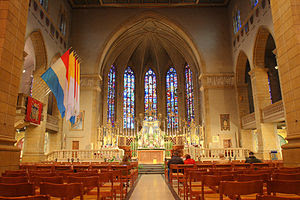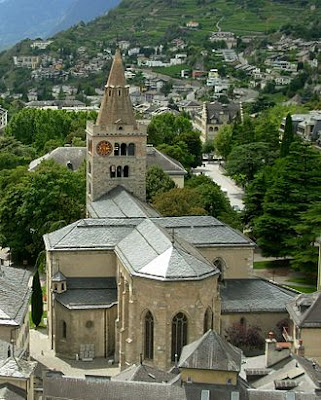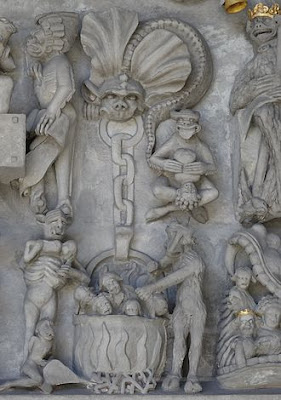Democratic Republic of the Congo
The Kingdom of Kongo consisted of a large part of central Africa from the 14th to the 19th Centuries. King Leopold II of Belgium acquired the Congo as his personal property in the 1870s. Leopold forced the people to work on rubber plantations and millions died. International pressure forced Leopold to make the area a colony of Belgium at which time it became known as the Belgium Congo. The Congo gained its independence from Belgium in 1960 and it became Zaire in 1965. Ethnic strife and civil war erupted in mid-1990s during which time the Archbishop of Bukavu was assassinated and the nation became known as the Democratic Republic of the Congo.
Catholic missionaries first came to the Congo in 1490, but modern evangelization did not begin until the late 1800s. Today, the Democratic Republic of the Congo has 102 million people. Estimates of religious affiliation of its people varies greatly. Catholics account for between 40 to 50 percent and other Christians for 40 to 50 percent. These other Christians included Protestants as well as quasi-Christian African churches. About 1 to 5 percent of the people as Muslim. There are six Catholic provinces: Bukava, Kananga, Kinshasa, Kisangani, Lubumbashi, and Mbandaka-Bikoro. Maronite-rite Catholics are under the jurisdiction of the Diocese of the Annunciation in Ibadan, Nigeria.
Province of Kinshasa
The province consists of the civil provinces of Kinshasa, Kongo Central, Kwango, Kwilu, and Mai-Ndombe in west central Congo. The Mission sui juris of Congo was established in 1886 and this became an apostolic vicariate in 1888. It was promoted to the Metropolitan Archdiocese of Leopoldville in 1959 and acquired its current name in 1966.
Our Lady (Notre Dame) of the Congo Cathedral in Kinshasa was built in 1947.
The first picture is from Panaramio and the other two are from TripAdvisor.
The Province has eight suffragan dioceses.
- The Diocese of Kikwit was established as a Mission sui juris in 1892, became an apostolic prefecture in 1903, an apostolic vicariate in 1928, and a diocese in 1959.
- The Diocese of Matadi was established as an apostolic prefecture in 1911, became an apostolic vicariate in 1930, and a diocese in 1959.
- The Diocese of Kisantu was established as an apostolic vicariate in 1931 and became a diocese in 1959.
- The Diocese of Boma was established as an apostolic vicariate in 1934 and became a diocese in 1959.
- The Diocese of Idiofa was established as an apostolic prefecture in 1937, became an apostolic vicariate in 1948, and a diocese in 1959.
- The Diocese of Inongo was established as an apostolic vicariate in 1953 and became a diocese in 1959.
- The Diocese of Popokabaka was established in 1961.
- The Diocese of Kenge was established as an apostolic prefecture in 1957 and became a diocese in 1963.
Province of Kisangani
The province consists of the civil provinces of Bas-Uele, Haut-Uele, Ituri, and Tshopo in northeastern Congo. The Apostolic Prefecture of Stanley Falls was established in 1904, became an apostolic vicariate in 1908, and became the Metropolitan Archdiocese of Stanleyville in 1959. It acquired its current name in 1966.
Our Lady of the Rosary Cathedral in Kisangani was built in 1899 and it has been restored several times.
From Wikipedia.
The Province has eight suffragan dioceses.
- The Diocese of Buta was established as an apostolic prefecture in 1898, became an apostolic vicariate in 1924, and a diocese in 1959.
- The Diocese of Isiro-Niangara was established as an apostolic prefecture in 1911, became an apostolic vicariate in 1924, and a diocese in 1959.
- The Diocese of Bunia was established as an apostolic prefecture in 1922, became an apostolic vicariate in 1933, and a diocese in 1959.
- The Diocese of Bondo was established as an apostolic prefecture in 1926, became an apostolic vicariate in 1937, and a diocese in 1959.
- The Diocese of Wamba was established as an apostolic vicariate in 1949 and became a diocese in 1959.
- The Diocese of Isangi was established as an apostolic prefecture in 1951 and became a diocese in 1962.
- The Diocese of Mahagi-Nioka was established in 1962.
- The Diocese of Doruma-Dungu was established as an apostolic prefecture in 1958 and became a diocese in 1967.
Province of Kananga
The province consists of the civil provinces of Lomami, Kasai, Kasai-Central, Kasai-Oriental, and Sankuru in the central part of the Congo. The Mission sui juris of Upper Kasai was established in 1901. This became an apostolic prefecture in 1904, an apostolic vicariate in 1917, and a metropolitan archdiocese in 1959.
The Cathedral of St. Joseph is in Mikalayi, about 22 miles southwest of Kananga. This was the first settlement of Catholic missionaries in Kasai in 1891.
From a local website.
The Pro-Cathedral of St. Clement is in Kananga.
The first picture is from a local website and the second is from Panaramio.
The Province has eight suffragan dioceses.
- The Diocese of Tshumbe was established as an apostolic prefecture in 1936, became an apostolic vicariate in 1947, and a diocese in 1959.
- The Diocese of Kabinda was established as an apostolic vicariate in 1953 and was promoted to a diocese in 1959.
- The Diocese of Luebo was established as an apostolic vicariate in 1959 and became a diocese later that year.
- The Diocese of Mweka was established as an apostolic prefecture in 1953 and became a diocese in 1964.
- The Diocese of Mbujimayi was established as an apostolic administration in 1963 and became a diocese in 1966.
- The Diocese of Kole was established as an apostolic prefecture in 1951 and became a diocese in 1967.
- The Diocese of Lwiza was established in 1967.
- The Diocese of Tshilomba was established in 2022.
Province of Lubumbashi
The province consists of the civil provinces of Haut-Katanga, Haut-Lomami, Lualaba, and Tanganyika in southern Congo. The apostolic prefecture of Katanga was established in 1910, became an apostolic vicariate in 1932 and a metropolitan archdiocese in 1959.
Sts. Peter and Paul Cathedral in Lubumbashi was built in 1920 in a Romanesque Revival style.
Both pictures are from Wikipedia.
The Province has seven suffragan dioceses.
- The Diocese of Kalemie-Kirungu was established as an apostolic vicariate in 1887 and a diocese in 1959.
- The Diocese of Kongolo was established as an apostolic prefecture in 1911, became an apostolic vicariate in 1935, and became a diocese in 1959.
- The Diocese of Kamina was established as an apostolic prefecture in 1922, became an apostolic vicariate in 1934, and became a diocese in 1959.
- The Diocese of Sakania-Kipushi was established as an apostolic prefecture in 1925, became an apostolic vicariate in 1939, and a diocese in 1959.
- The Diocese of Kilwa-Kasenga was established as an apostolic prefecture in 1948 and became a diocese in 1962.
- The Diocese of Kolwezi was established in 1971.
- The Diocese of Manono was established in 1971.
Province of Mbandaka-Bikoro
The province consists of the civil provinces of Equateur, Mongala, Nord-Ubangi, Sud-Ubangi, and Tshuapa in northwestern Congo. The Apostolic Prefecture of Tsuapa was established in 1924, became the Apostolic Vicariate of Coquilhatville in 1932, and a metropolitan archdiocese in 1959. It acquired its current name in 1975.
The Cathedral of St. Eugene in Mbankaka was built by Trappist missionaries between 1910 and 1914. It was built primarily with bricks (hundreds of thousands of them) and has a bell that came from Westmalle Abbey in Belgium. [As an aside, the Trappist monks at Westmalle Abbey operate a brewery and one of their beers is considered to be one of the best in the world.]
The first picture is from a blog and the second is from Wikipedia.
The Co-Cathedral of St. Vincent de Paul is in Bikoro.
The Province has six suffragan dioceses.
- The Diocese of Lisala was established as an apostolic vicariate in 1919 and a diocese in 1959.
- The Diocese of Molegbe was established as an apostolic prefecture in 1911, became an apostolic vicariate in 1935, and a diocese in 1959.
- The Diocese of Basankusu was established as an apostolic prefecture in 1926, became an apostolic vicariate in 1948, and a diocese in 1959.
- The Diocese of Bokungu-Ikela was established in 1961.
- The Diocese of Lolo was established as an apostolic prefecture in 1937 and became a diocese in 1962.
- The Diocese of Budjala was established in 1964.
Province of Bukavu
The province consists of the civil provinces of Maniema, North Kivu, and South Kivu in the east central part of the Congo. The Metropolitan Archdiocese of Bukavu started as an apostolic vicariate in 1929 and became a metropolitan archdiocese in 1959.
The brick Our Lady of Peace Cathedral in Bukavu was built between 1948 and 1951.
The top picture is from a blog and the bottom picture is from Wikipedia.
The Province has five suffragan dioceses.
- The Diocese of Butembo-Beni was established as a Mission sui juris in 1934, became an apostolic vicariate in 1938, and a diocese in 1959. It acquired its current name in 1967.
- The Diocese of Kasongo was established as an apostolic vicariate in 1952 and became a diocese in 1959.
- The Diocese of Kindu was established as an apostolic vicariate in 1956 and became a diocese in 1959.
- The Diocese of Goma was established as an apostolic vicariate in 1959 and became a diocese later that same year.
- The Diocese of Uvira was established in 1962.
Definitions
The Catholic Church is mostly divided into ecclesiastical provinces—a province consists of a metropolitan archdiocese and one or more dioceses. The province and the archdiocese are led by an archbishop. Each of the dioceses is called a suffragan diocese and is led by a bishop. Archbishops have some responsibilities for the province, but all bishops answer directly to the Pope. There are also missionary jurisdictions below the level of a diocese including apostolic vicariates, apostolic prefectures, apostolic administrations, and Missions sui juris.































































































































